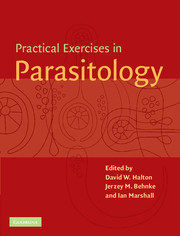Book contents
- Frontmatter
- Contents
- List of contributors
- Preface
- General advice
- 1 Observational Exercises on Parasites
- A Local wild and domestic hosts as sources of parasites
- 1.1 Parasites of the earthworm: Monocystis (Protozoa) and Rhabditis (Nematoda)
- 1.2 Parasites of marine molluscs (Littorina)
- 1.3 Parasites offish: (a) Whiting and Diclidophora merlangi (Monogenea)
- 1.4 Parasites of fish: (b) Plaice/flounder and Lepeophtheirus pectoralis (Copepoda)
- 1.5 Parasites of domestic livestock: (a) Pig and Ascaris suum (Nematoda)
- 1.6 Parasites of domestic livestock: (b) Sheep and Fasciola hepatica (Trematoda)
- 1.7 Parasites of crops: Potato cyst nematode (PCN) Globodera pallida (Nematoda)
- B Laboratory maintained species
- 2 Ecology
- 3 Physiology and Biochemistry
- 4 Pathology and Immunology
- 5 Chemotherapy
- 6 Molecular Parasitology
- 7 Behaviour
- Appendix 1 Reagent index
- Appendix 2 UK suppliers
- Appendix 3 US suppliers
- Index
1.2 - Parasites of marine molluscs (Littorina)
Published online by Cambridge University Press: 05 June 2012
- Frontmatter
- Contents
- List of contributors
- Preface
- General advice
- 1 Observational Exercises on Parasites
- A Local wild and domestic hosts as sources of parasites
- 1.1 Parasites of the earthworm: Monocystis (Protozoa) and Rhabditis (Nematoda)
- 1.2 Parasites of marine molluscs (Littorina)
- 1.3 Parasites offish: (a) Whiting and Diclidophora merlangi (Monogenea)
- 1.4 Parasites of fish: (b) Plaice/flounder and Lepeophtheirus pectoralis (Copepoda)
- 1.5 Parasites of domestic livestock: (a) Pig and Ascaris suum (Nematoda)
- 1.6 Parasites of domestic livestock: (b) Sheep and Fasciola hepatica (Trematoda)
- 1.7 Parasites of crops: Potato cyst nematode (PCN) Globodera pallida (Nematoda)
- B Laboratory maintained species
- 2 Ecology
- 3 Physiology and Biochemistry
- 4 Pathology and Immunology
- 5 Chemotherapy
- 6 Molecular Parasitology
- 7 Behaviour
- Appendix 1 Reagent index
- Appendix 2 UK suppliers
- Appendix 3 US suppliers
- Index
Summary
Aims and objectives
This exercise is designed to demonstrate:
A range of digenean parasites of Littorina spp.
The general morphology of the intermediate stages of Digenea.
Introduction
The larval stages of digenetic trematodes develop in intermediate hosts, almost all of which belong to the phylum Mollusca. The miracidium hatches from the egg and penetrates the molluscan host giving rise to the next larval stage (the first intramolluscan stage), the primary or mother sporocyst. In some trematodes, development of cercariae occurs directly within the secondary or daughter sporocysts; in others, cercariae develop within rediae. In both cases, development usually takes place in the gonad or digestive gland of the molluscan host.
The digestive glands of gastropod molluscs exhibit profound physico-chemical changes as a result of infection with larval trematodes. The observable manifestations of these changes are apparent in alterations in the structure, histochemistry and biochemistry of the molluscan digestive gland. Excellent reviews of the subject are provided by Wright (1971) and Smyth and Halton (1983).
During this exercise, you will be examining specimens of the marine mollusc, Littorina (the common or edible periwinkle) for infection with a variety of digenean parasites. Other species may be common locally and could be examined additionally or substituted if necessary.
- Type
- Chapter
- Information
- Practical Exercises in Parasitology , pp. 19 - 30Publisher: Cambridge University PressPrint publication year: 2001
- 1
- Cited by



